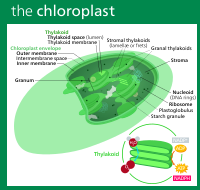
Photo from wikipedia
In recent years, marine macroalgae with extensive biomass have attracted the attention of researchers worldwide. Furthermore, algal polysaccharides have been widely studied in the food, pharmaceutical, and cosmetic fields because… Click to show full abstract
In recent years, marine macroalgae with extensive biomass have attracted the attention of researchers worldwide. Furthermore, algal polysaccharides have been widely studied in the food, pharmaceutical, and cosmetic fields because of their various kinds of bioactivities. However, there are immense barriers to their application as a result of their high molecular size, poor solubility, hydrocolloid nature, and low physiological activities. Unique polysaccharides, such as laminarin, alginate, fucoidan, agar, carrageenan, porphyran, ulvan, and other complex structural polysaccharides, can be digested by marine bacteria with many carbohydrate-active enzymes (CAZymes) by breaking down the limitation of glycosidic bonds. However, structural elucidation of algal polysaccharides, metabolic pathways, and identification of potential polysaccharide hydrolases that participate in different metabolic pathways remain major obstacles restricting the efficient utilization of algal oligosaccharides. This review focuses on the structure, hydrolase families, metabolic pathways, and potential applications of seven macroalgae polysaccharides. These results will contribute to progressing our understanding of the structure of algal polysaccharides and their metabolic pathways and will be valuable for clearing the way for the compelling utilization of bioactive oligosaccharides.
Journal Title: Journal of agricultural and food chemistry
Year Published: 2022
Link to full text (if available)
Share on Social Media: Sign Up to like & get
recommendations!